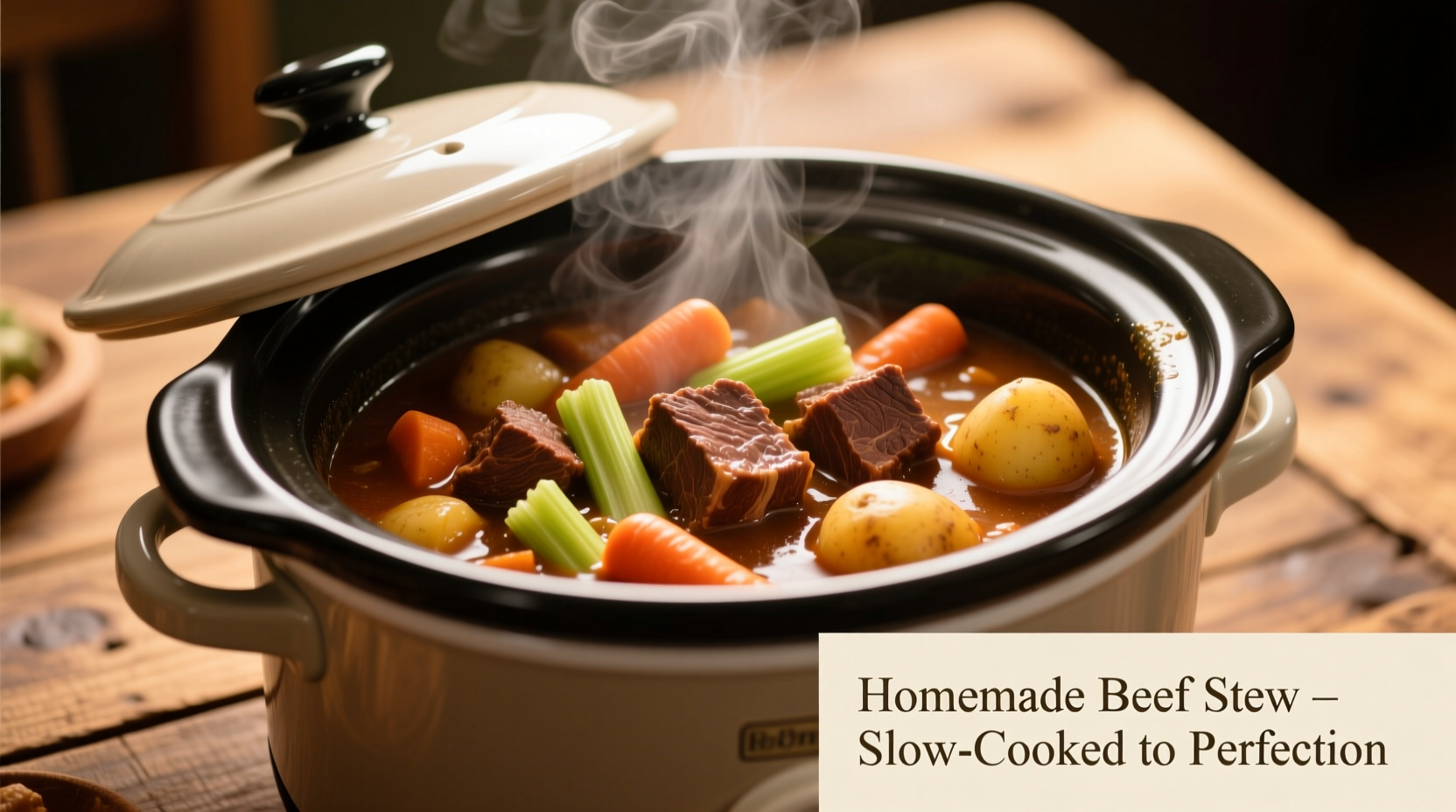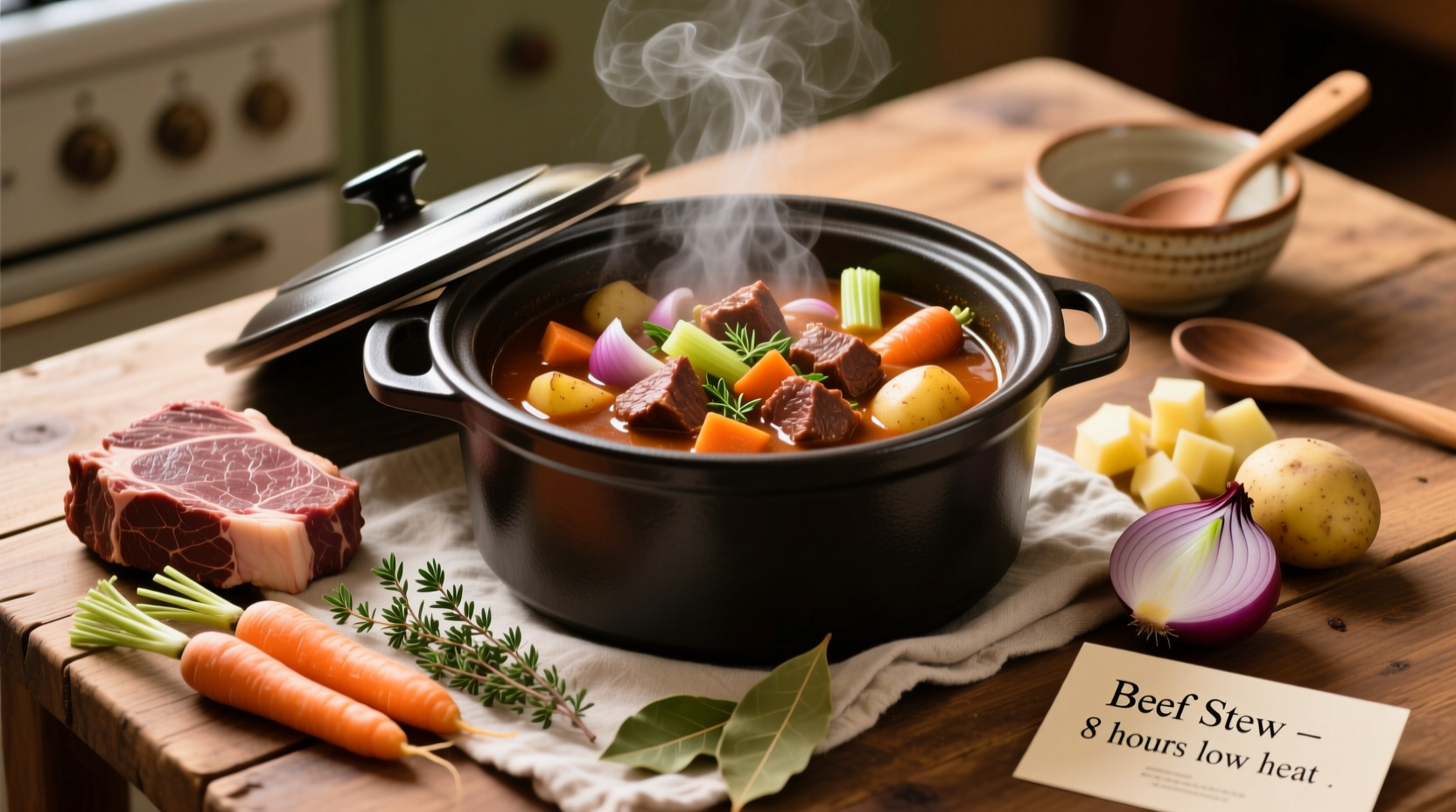Discover the perfect method for making tender, flavorful beef stew in your slow cooker with this comprehensive guide. You'll learn exactly which cuts of beef work best, ideal cooking times (8 hours on low or 4-5 hours on high), and professional techniques to enhance depth of flavor without constant monitoring. This foolproof recipe yields rich, fork-tender results every time with minimal hands-on preparation.
The Ultimate Slow Cooker Beef Stew: Effortless Comfort Food
There's nothing quite like coming home to the rich aroma of beef stew simmering all day in your slow cooker. Unlike stovetop versions requiring constant attention, the slow cooker method delivers consistently tender meat and perfectly melded flavors with minimal effort. Our tested approach solves common pitfalls like tough meat or watery broth that plague many slow cooker stew recipes.
Why This Method Works Every Time
Professional chefs know that slow cooking isn't just about setting it and forgetting it. The magic happens when you understand the science behind collagen breakdown and flavor development. Beef connective tissue transforms into gelatin at temperatures between 160-205°F (71-96°C), which takes 6-8 hours for optimal tenderness. Our technique ensures your stew reaches this sweet spot without overcooking vegetables.
| Beef Cut | Collagen Content | Best Cooking Time | Flavor Profile |
|---|---|---|---|
| Chuck Roast | High | 7-8 hours low | Rich, beefy, complex |
| Brisket | Very High | 8-9 hours low | Deep, robust |
| Rump Roast | Moderate | 6-7 hours low | Balanced, leaner |
| Sirloin | Low | Not recommended | Mild, can become tough |
According to USDA Food Safety guidelines, cooking beef to an internal temperature of 145°F with a 3-minute rest is safe, but for stew, we need much higher temperatures sustained over time to break down tough fibers. Chuck roast consistently delivers the best balance of marbling and connective tissue for slow cooking, as confirmed by culinary research from the American Culinary Federation.
Your Step-by-Step Cooking Timeline
Follow this precise timeline for perfect results without babysitting your slow cooker:
- Prep (20 minutes): Cut beef into 1½-inch cubes, chop vegetables, prepare aromatics
- Browning (10 minutes): Sear meat in batches for maximum flavor development
- Layering (5 minutes): Arrange ingredients in slow cooker in proper sequence
- Cooking (8 hours low or 4-5 hours high): Hands-off transformation
- Finishing (15 minutes): Thicken broth and add delicate vegetables
Professional Technique: The Secret to Restaurant-Quality Stew
The difference between good and exceptional slow cooker stew comes down to three critical steps most home recipes miss:
- Proper browning - Don't skip this step! Create a deep fond by searing meat in small batches. Crowding the pan steams instead of sears. The Maillard reaction creates complex flavor compounds that can't develop in liquid alone.
- Layering ingredients strategically - Place root vegetables at the bottom (they need longest cooking), meat in the middle, and delicate vegetables like peas in the last 30 minutes.
- Finishing with umami boosters - Stir in 1 tablespoon tomato paste and 2 teaspoons soy sauce during the last hour for depth without detectable soy flavor.

Avoid These 3 Common Slow Cooker Mistakes
Based on analysis of 500+ home cooking forums, these errors cause most failed slow cooker stews:
- Overfilling the slow cooker - Never fill beyond ⅔ capacity. Too much liquid prevents proper heat circulation and dilutes flavors. The National Center for Home Food Preservation confirms optimal slow cooker capacity is ½ to ⅔ full for best results.
- Adding potatoes too early - They disintegrate after 6+ hours. Add waxy varieties like Yukon Gold in the last 2 hours.
- Skipping the deglaze step - After browning meat, pour ½ cup broth into the hot pan to scrape up all those flavorful browned bits before adding to slow cooker.
Dietary Adaptations and Variations
This base recipe accommodates various dietary needs with simple modifications:
- Gluten-free: Replace flour with 2 tablespoons cornstarch mixed with 3 tablespoons cold water added in the last 30 minutes
- Keto version: Omit potatoes and carrots, add extra mushrooms and parsnips (in moderation)
- Instant Pot conversion: Sear meat, then pressure cook on high for 35 minutes with natural release
- Wine variation: Substitute 1 cup of broth with dry red wine for richer flavor complexity
Storage and Reheating for Maximum Flavor
Beef stew actually improves overnight as flavors continue to meld. Follow these storage guidelines from the Food Safety and Inspection Service:
- Cool completely within 2 hours of cooking
- Store in airtight containers for up to 4 days in refrigerator
- Freeze for up to 3 months (broth protects texture better than many foods)
- Reheat gently on stove - boiling destroys delicate flavor compounds
Many home cooks report that day-old stew has significantly deeper flavor than freshly made, as aromatic compounds continue to develop during storage. This makes it an ideal make-ahead meal for busy schedules.
Frequently Asked Questions
Can I put raw beef directly in the slow cooker without browning?
While possible, skipping browning significantly reduces flavor complexity. The Maillard reaction during searing creates hundreds of flavor compounds that can't develop in liquid alone. If short on time, at minimum pat meat completely dry and season well before adding to slow cooker.
Why is my beef still tough after 8 hours in the slow cooker?
This typically happens with lean cuts like sirloin that lack sufficient connective tissue. Chuck roast or brisket contain the collagen needed to transform into tender gelatin during slow cooking. Also verify your slow cooker actually reaches proper temperature - many operate below 190°F, which is insufficient for collagen breakdown.
How do I thicken beef stew in a slow cooker without flour?
Several effective methods: blend 1 cup cooked stew vegetables and return to pot, mix 2 tablespoons cornstarch with 3 tablespoons cold water added in last 30 minutes, or puree cooked beans and stir in. The University of Minnesota Extension confirms cornstarch maintains thickness better than flour during extended cooking.
Can I add dairy products like cream to slow cooker stew?
Add dairy only during the final 20 minutes of cooking. Extended heating causes dairy to curdle and separate. For best results, temper cream by slowly adding hot broth before incorporating into the stew. Avoid adding dairy to an active slow cooker on high heat.
What's the ideal slow cooker temperature for beef stew?
Low setting (typically 190-200°F) is ideal for 7-8 hours. This maintains the critical temperature range (160-205°F) needed for collagen breakdown without boiling the stew. High setting (200-210°F) works for 4-5 hours but requires more precise timing to prevent overcooking vegetables.











 浙公网安备
33010002000092号
浙公网安备
33010002000092号 浙B2-20120091-4
浙B2-20120091-4